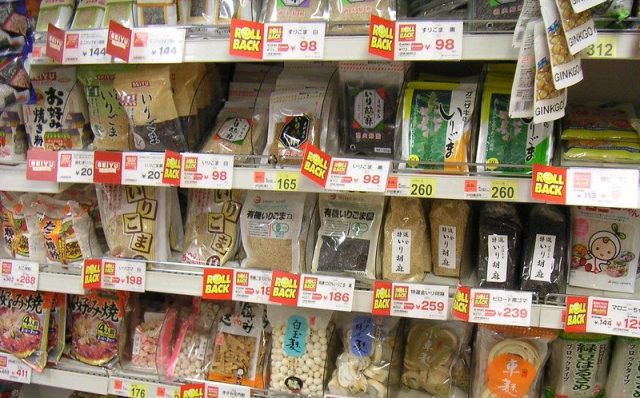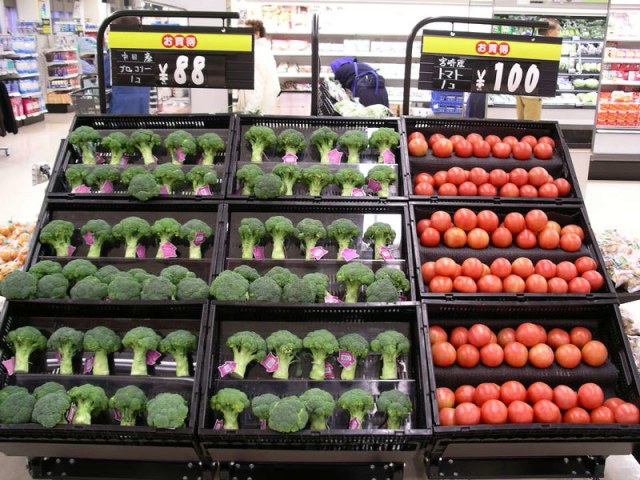
Seiyu might be setting a precedent with their easily stackable product tubs.
Aestheticism is highly prized in Japan. From the daintiest ribbon-wrapped Coke bottle to the broad, clean streets, how things look is just about as important as how they operate.
For a great example of this in action, just look at the majority of Japanese supermarkets. You’ll find pristine racks of products lined in single file, and they’ll be reorganized right away when a customer disrupts the presentation by removing something.
▼ Regimented rows of vegetables at a supermarket.
But… is it necessary to put such importance on aesthetics at a supermarket? One Seiyu supermarket store is taking a stand.
▼ “This is really true. More supermarkets should follow suit.” (Sign translation below)
ほんまこれやからまじでどこのスーパーも見習うべき。 pic.twitter.com/5nHRnscRJA
— とまとにんじん。 (@jp_tomato) January 8, 2020
The sign pictured reads:
“We stack our shelves for efficiency rather than attractiveness.
The rows of cup ramen and snack baskets may look as though they have been thrown together haphazardly. However we find that stacking them in this way drastically increases our efficiency. This helps us to offer you products at such low prices.”
The user who posted the picture clearly feels strongly about this method, as they went on to outline many of the arguments about stacking in this way — and then rebutted each one in turn.
“‘It’s hard to see the best before date.’
Do you really need to see each date, when most items from a shipment will have the same one?”“‘If you don’t stack them neatly, it’s hard to see the packaging.’
You can’t see the top or bottom of most neatly packed products either, and if you take one out to check and then decide to put it back, you have to make sure it looks good.”“‘The value of products will decline if they’re stacked like this.’
Just like Seiyu said in their announcement, this stacking rule only applies to snacks and cup ramen (though it wouldn’t especially bother me anyway.)”“‘It’ll be a pain to take stock of the products.’
What if you just used a bunch of grocery carts while taking stock, filled them with the total amount of one item, and then throw them into the display basket as you inspect them?”“‘I hate how messy this kind of display looks so I never buy products stacked like this.’
To each their own. No one is saying you have to shop at supermarkets that stack like this.”
Then, to demonstrate against the argument for package visibility, they posted this follow-up image.
▼ (Translation below)
・乱雑に入れてあるとパッケージが見にくい
— とまとにんじん。 (@jp_tomato) January 9, 2020
同スーパーで綺麗に積まれた写真を頂きました。コンビニのように上部が正面に無く余計に見にくいとわたくしは感じる。乱雑に入れられていると多方向が自然と見えるのでは?そもそも定番商品の場合パッケージを見ずに値段だけ見て買う事の方が多い気がする。 pic.twitter.com/ICC8QaUuIn
“I took a photo from the same supermarket of the products stacked together nicely. I feel like you still can’t see the top of the packaging, just like how they’re packed in a convenience store. But if they’re all jumbled together, they face in all kinds of directions, right? So you’re more likely to see the package. Anyway, with regular products like this I feel like more people buy it after checking the price without even glancing at the package.”
There was a considerable amount of backlash from some commenters, who insisted that taking that extra time and care to make things look presentable is part of the Japanese spirit, and it’s a sad thing to see it passed over in favor of efficiency. Others compared Seiyu’s messy shelves to other well-known budget stores like Don Quijote, while others said “it looks like a supermarket from abroad”.
Those last commenters might be onto something. You see, the majority of shares in Seiyu are owned by an American retailer: Wal-Mart.
For what it’s worth, more than one commenter said “I think it looks better stacked in a jumble”. Beauty really is in the eye of the beholder!
Source: Twitter/@jp_tomato via My Game News Flash
Featured image: Flickr/Brand New Films
Insert image: Flickr/Jacob Levine
● Want to hear about SoraNews24’s latest articles as soon as they’re published? Follow us on Facebook and Twitter!


 The next must-have item for game fans: Adorable stackable Kirbys!
The next must-have item for game fans: Adorable stackable Kirbys! Here are Japan’s favorite ice creams from last month! Vanilla wins by a mile…
Here are Japan’s favorite ice creams from last month! Vanilla wins by a mile… Japanese police face criticism for improper handling of stolen Pokémon and Yu-Gi-Oh cards【Video】
Japanese police face criticism for improper handling of stolen Pokémon and Yu-Gi-Oh cards【Video】 Japanese convenience store or Japanese supermarket: Which one is cheaper?
Japanese convenience store or Japanese supermarket: Which one is cheaper? Japanese confectionary chain Chateraise opens first 24-hour branch with self-checkout
Japanese confectionary chain Chateraise opens first 24-hour branch with self-checkout Demon Slayer: Kimetsu no Yaiba gets new roller coaster attractions and food at Universal Studios Japan
Demon Slayer: Kimetsu no Yaiba gets new roller coaster attractions and food at Universal Studios Japan Japan’s new difficult-to-drink-from beer glass protects your liver, but it’s a brutal experience
Japan’s new difficult-to-drink-from beer glass protects your liver, but it’s a brutal experience New Nintendo Lego kit is a beautiful piece of moving pixel art of Mario and Yoshi【Photos】
New Nintendo Lego kit is a beautiful piece of moving pixel art of Mario and Yoshi【Photos】 How to order snacks on a Shinkansen bullet train in Japan
How to order snacks on a Shinkansen bullet train in Japan New samurai glasses are Japan’s latest weird must-have souvenir
New samurai glasses are Japan’s latest weird must-have souvenir Come play hide-and-seek on a deserted Japanese island this August and November
Come play hide-and-seek on a deserted Japanese island this August and November New Pokémon ice cream, dessert drinks, and cool merch coming to Baskin-Robbins Japan【Pics】
New Pokémon ice cream, dessert drinks, and cool merch coming to Baskin-Robbins Japan【Pics】 Caffeinated ramen for gamers that you can eat with one hand going on sale in Japan
Caffeinated ramen for gamers that you can eat with one hand going on sale in Japan Starbucks Japan unveils New Year’s collection for 2024, with daruma, dragons and Mt Fuji for luck
Starbucks Japan unveils New Year’s collection for 2024, with daruma, dragons and Mt Fuji for luck Real Buddhist monk plays Super Mario Bros., recites prayers every time he kills an enemy【Video】
Real Buddhist monk plays Super Mario Bros., recites prayers every time he kills an enemy【Video】 Nintendo history you can feel – Super NES, N64, and GameCube controllers become capsule toys
Nintendo history you can feel – Super NES, N64, and GameCube controllers become capsule toys Hello, cosmetics! Clinique teams up with Hello Kitty this summer for first-time collaboration
Hello, cosmetics! Clinique teams up with Hello Kitty this summer for first-time collaboration “The most Delicious Cup Noodle in history” – Japan’s French Cup Noodle wins our heart【Taste test】
“The most Delicious Cup Noodle in history” – Japan’s French Cup Noodle wins our heart【Taste test】 Starbucks releases a cute Frappuccino and Unicorn Cake…but not in Japan
Starbucks releases a cute Frappuccino and Unicorn Cake…but not in Japan Kyoto Tower mascot termination reveals dark side behind cute Japanese characters
Kyoto Tower mascot termination reveals dark side behind cute Japanese characters McDonald’s Japan’s Soft Twist Tower: A phantom ice cream only sold at select branches
McDonald’s Japan’s Soft Twist Tower: A phantom ice cream only sold at select branches Yabai Ramen: What makes this Japanese ramen so dangerous?
Yabai Ramen: What makes this Japanese ramen so dangerous? Finally! Nintendo Japan expands Switch 8-bit controller sales to everybody, Online member or not
Finally! Nintendo Japan expands Switch 8-bit controller sales to everybody, Online member or not Japanese government wants to build luxury resorts in all national parks for foreign tourists
Japanese government wants to build luxury resorts in all national parks for foreign tourists To combat declining birth rate, Japan to begin offering “Breeding Visas” to foreigners
To combat declining birth rate, Japan to begin offering “Breeding Visas” to foreigners 10 things you should buy at 7-Eleven in Japan
10 things you should buy at 7-Eleven in Japan Studio Ghibli releases anime heroine cosplay dresses that are super comfy to wear
Studio Ghibli releases anime heroine cosplay dresses that are super comfy to wear Woman charged for driving suitcase without a license in Osaka
Woman charged for driving suitcase without a license in Osaka Studio Ghibli unveils My Neighbour Totoro miniature house model
Studio Ghibli unveils My Neighbour Totoro miniature house model Kyoto experiencing problems with foreign tourists not paying for bus fares, but not on purpose
Kyoto experiencing problems with foreign tourists not paying for bus fares, but not on purpose Fighting mild hunger with a Japanese soda that turns into jelly in the stomach【Taste test】
Fighting mild hunger with a Japanese soda that turns into jelly in the stomach【Taste test】 Studio Ghibli’s Howl’s Moving Castle tapestry unveiled in Japan for first time
Studio Ghibli’s Howl’s Moving Castle tapestry unveiled in Japan for first time McDonald’s new Happy Meals offer up cute and practical Sanrio lifestyle goods
McDonald’s new Happy Meals offer up cute and practical Sanrio lifestyle goods Sales of Japan’s most convenient train ticket/shopping payment cards suspended indefinitely
Sales of Japan’s most convenient train ticket/shopping payment cards suspended indefinitely Sold-out Studio Ghibli desktop humidifiers are back so Totoro can help you through the dry season
Sold-out Studio Ghibli desktop humidifiers are back so Totoro can help you through the dry season Japanese government to make first change to romanization spelling rules since the 1950s
Japanese government to make first change to romanization spelling rules since the 1950s Foreigner’s request for help in Tokyo makes us sad for the state of society
Foreigner’s request for help in Tokyo makes us sad for the state of society Ghibli founders Toshio Suzuki and Hayao Miyazaki contribute to Japanese whisky Totoro label design
Ghibli founders Toshio Suzuki and Hayao Miyazaki contribute to Japanese whisky Totoro label design Doraemon found buried at sea as scene from 1993 anime becomes real life【Photos】
Doraemon found buried at sea as scene from 1993 anime becomes real life【Photos】 Tokyo’s most famous Starbucks is closed
Tokyo’s most famous Starbucks is closed Princesses, fruits, and blacksmiths: Study reveals the 30 most unusual family names in Japan
Princesses, fruits, and blacksmiths: Study reveals the 30 most unusual family names in Japan Japan has more anime/video game actresses than ever before, according to major seiyu magazine
Japan has more anime/video game actresses than ever before, according to major seiyu magazine The Japanese art of making trash containers from old papers
The Japanese art of making trash containers from old papers This is what a Whopper with 1,005 slices of cheese looks like in today’s financial climate
This is what a Whopper with 1,005 slices of cheese looks like in today’s financial climate We sample the Super Cup 1.5 times x Yoasobi collaboration cup ramen that’s now on sale
We sample the Super Cup 1.5 times x Yoasobi collaboration cup ramen that’s now on sale These new Cardcaptor Sakura basket purses are just as cute as Sakura herself
These new Cardcaptor Sakura basket purses are just as cute as Sakura herself Tokyo bento shop famous for jumbo orders offers a meaty sausage lunch for under 1,000 yen
Tokyo bento shop famous for jumbo orders offers a meaty sausage lunch for under 1,000 yen Japan continues to shun processed fish sticks, opts for minimally processed fish cubes instead
Japan continues to shun processed fish sticks, opts for minimally processed fish cubes instead We travel to Fuji to see how they make Japanese toilet paper
We travel to Fuji to see how they make Japanese toilet paper Amazingly organized Sailor Moon treasure drawer is inspiration to anime fans and neat freaks【Vid】
Amazingly organized Sailor Moon treasure drawer is inspiration to anime fans and neat freaks【Vid】 A cup ramen for Zen Buddhists: New Shindo Ramen Zendo noodles are meat, dairy and egg free
A cup ramen for Zen Buddhists: New Shindo Ramen Zendo noodles are meat, dairy and egg free The mesmerizing art of stacking Japanese coins 【Photos】
The mesmerizing art of stacking Japanese coins 【Photos】 We buy a sushi-restaurant-themed bath bomb that threatens to smell like the ocean
We buy a sushi-restaurant-themed bath bomb that threatens to smell like the ocean Japanese Twitter user spends eight years stacking toilet paper cores, completes entire wall
Japanese Twitter user spends eight years stacking toilet paper cores, completes entire wall Mini karate-chop roof tiles you can actually destroy are Japan’s newest capsule toy【Videos】
Mini karate-chop roof tiles you can actually destroy are Japan’s newest capsule toy【Videos】 Sega begins Puyo Puyo Boot Camp to help bring eSports into more Japanese high schools
Sega begins Puyo Puyo Boot Camp to help bring eSports into more Japanese high schools Starbucks celebrates its 25th anniversary in Japan with a special commemorative drinkware range
Starbucks celebrates its 25th anniversary in Japan with a special commemorative drinkware range
Leave a Reply